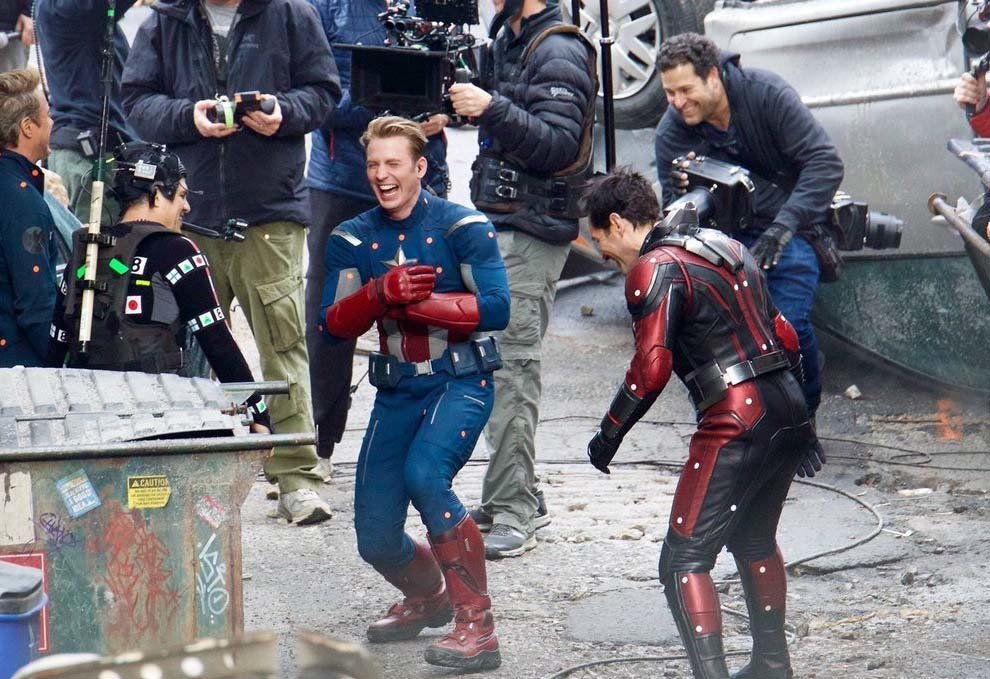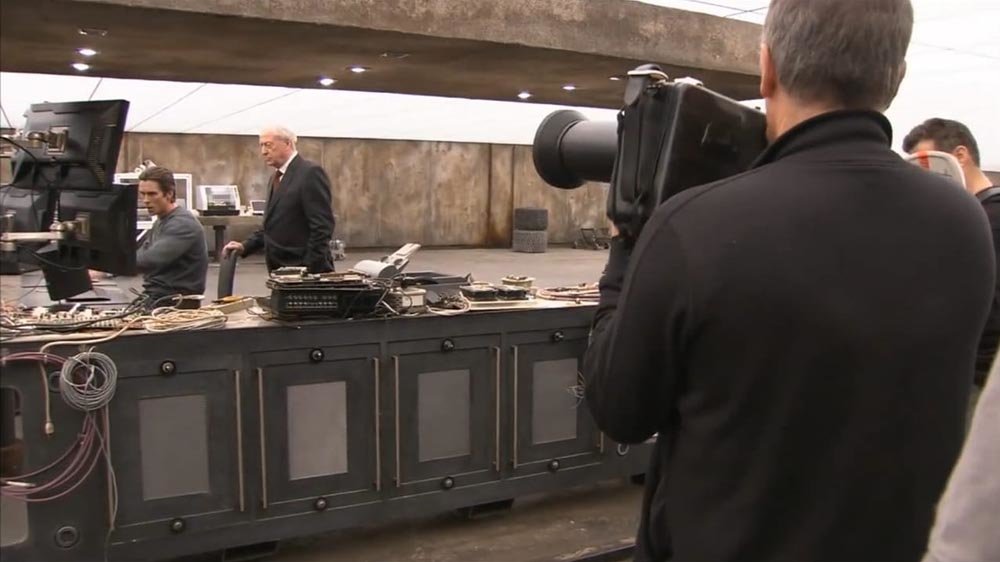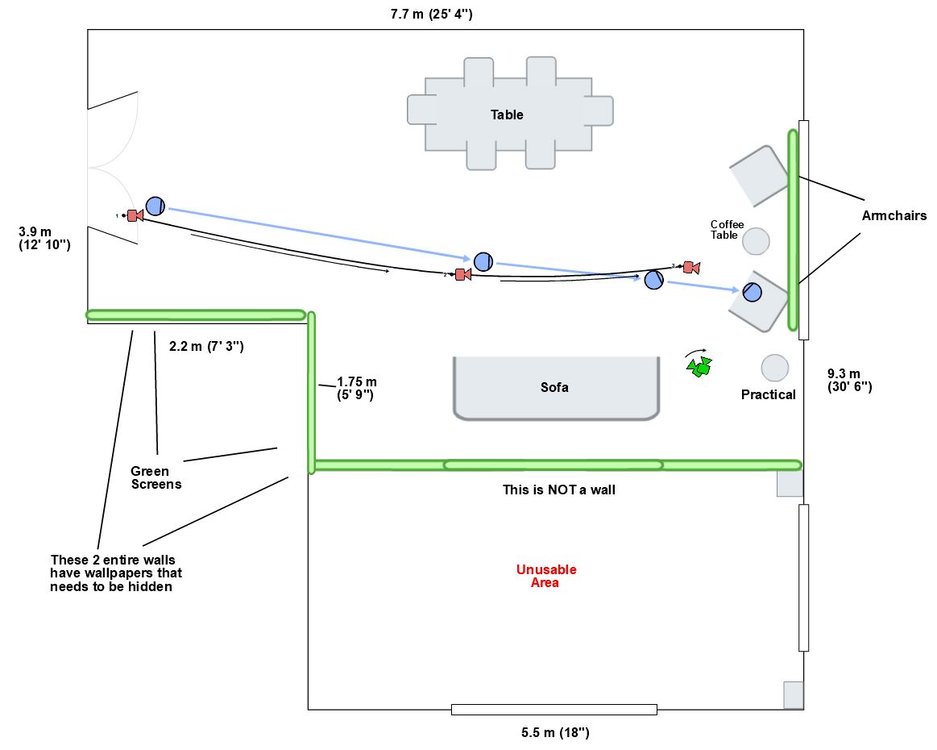-
Posts
33 -
Joined
-
Last visited
About Berker Taşkıran
- Birthday 05/02/1990
Profile Information
-
Occupation
Director
-
Location
Turkey
-
My Gear
BMPCC
-
Specialties
Writer-Director
-

Green Screen Setup for a Short
Berker Taşkıran replied to Berker Taşkıran's topic in Visual Effects Cinematography
I can backlight the large (5.5m) one. I'll be shooting RAW on Pocket, I'm not too worried about lighting - it seems to generally work. Should still do some more tests tough. Do you think the green will spill onto the armchairs? Most of the stuff, including the character's clothing, is white, btw. The set is a practical location. I don't have a lot of lights or budget for it - my main question is if I should do the green screen like this or some other way. Thanks for your concern tough. -
I'll be shooting a sci-fi short in a week. Should I stick to this setup or instead use a straight green screen dividing the room into two from the 2.2m wall? The location will have 7 scenes and 11 shots. Some steady some moving shots. In some shots the whole room must be seen. I also planned to add a 3d piano model behind the 2.2m and 1.75m walls. Is this the best possible setup? What kind of complications could I have if I do it like this? I have to use tracking markers obviously, but will it be harder to make the created parts of the room to match the real parts of the room with this? I also have to create matching floor if I follow this setup when extending the room into a whole rectangle. Will that be too hard? Any better ideas?
-
I've shot this 6 months ago, no budget, only a poor LED was used for lightning, rest is practicals. The LED had awful flickering which I realized too late and had to fix it on post, gave me incredible hard time, fortunately I "did" manage to fix it. I did all the audio on post which also was another pain. Both helped me learn some lessons. As you can see all shots are static, shot on a tripod, I didn't have a way to move my camera back then. I sent this to a few free-to-apply festivals online, haven't received any feedback positive/negative. Most people seen it in real life somewhat liked it, most obviously praising it technically, saying it to be a bit slow, as expected. I took some shortcuts while filming this, I had a few more scenes that I didn't film because I was lazy (more work/outside scenes), and I did most of the work including the post which was the most tedious part. I extended my list of gear a lot since then and now I have a shoulder rig and arguably a great powerful LED (without flicker!) and learnt a lot about lightning. I still have some needs most important ones being a smoother way to move the camera and record decent audio. Obviously gear doesn't make the film, you do. This is just some information about my situation. Right now I'm planning to shoot another short (got a bit sick of them, tbh) which will have more things going on and hopefully will be better technically as well, this time hoping to not take any shortcuts on shoot and hoping to offload some work from post.
-

What's the difference between Cut-In and Insert?
Berker Taşkıran replied to Berker Taşkıran's topic in General Discussion
Okay then, I got Insert and Cutaway covered now, but what about Cut-In? In thefreedictionary.com it says Cut-In is another word for Insert? Or if you can use insert for both cutaway and cut-in, then perhaps, as I said before, Insert is used for both and cutaway and cut-in are more specific? Just checked screenplays of Interstellar and The Dark Knight Rises, and the only term out of these I found used, is Insert. Cutaway and cut-in seems a bit redundant if you ask me. Even Insert doesn't make too much sense when you have no idea what the scale will be. A close up of an actual human being standing up and a cup of coffee sitting on a table should not be described with same term. -

What's the difference between Cut-In and Insert?
Berker Taşkıran replied to Berker Taşkıran's topic in General Discussion
Then how about cutaway vs cut-in? Here, he describes cutaway as something in or out of the scene. Which contradicts to what I read about, I thought cutaway was cutting to outside of the scene. Insert obviously can't be cutting to outside of the scene. Is insert a general description that includes both? But still the question of cutaway vs cut-in remains. If any 2 of these 3 terms means the same thing, which one is used where? E.g. is one used only in screenplays and one during shooting, something along those lines? -
I can't seem to find anything on the internet which seems... weird. Both is showing something that exists within the scene in closer detail, right? I know the difference between cutaway and cut-in, and cutaway and insert but not between cut-in and insert. So it's just two different words for exact same thing..? For some reason it makes me uncomfortable to assume that.
-

How did they light these amazing shots?
Berker Taşkıran replied to Berker Taşkıran's topic in Lighting for Film & Video
So then can I assume that other than lighting the background the way you like it, the color of the lighting isn't something to worry about if you have the production design and color grading in place? My whole concern was that I was always thinking about the grading until the moment I started to get into lighting and then thought for a second that to achieve such colors you needed to pay great attention to color of the lighting. I can live with trying to figure out shaping the light and the shadows but if color plays such great role in it, it would introduce a whole other element to the picture (pun not intended) so that was what I wanted to get out of my head. -

How did they light these amazing shots?
Berker Taşkıran replied to Berker Taşkıran's topic in Lighting for Film & Video
How does one achieve such different colors? In the first image the shirt is greenish but the highlights of faces and hands and the watch aren't affected by green color. There's also some yellowish highlights in the background. Is this done by color grading using secondaries with tracking? That was my first assumption but Hannibal is filled with such shots, I don't see how to do that without spending a lot of time. The second image, again, has different colors for highlights, the background and the face. That shot look like a bit simpler since the background and foreground is easily apart. But the question is, is it the work of grading or lighting using different color lights? -

How did they light these amazing shots?
Berker Taşkıran replied to Berker Taşkıran's topic in Lighting for Film & Video
Huh. Sorry about that. 1st image: http://i.hizliresim.com/3vR4jp.jpg 2nd image: http://i.hizliresim.com/R1659n.gif 3rd image: http://i.hizliresim.com/pXYQ8n.png -
https://thenerdicon.files.wordpress.com/2013/06/hannibals01e09-2406.jpg http://67.media.tumblr.com/78b4c8d73746e81cd91f3871130e56f2/tumblr_n3x18n0Cft1rjp8eoo2_500.gif http://img2.tvtome.com/i/u/0e58a6975ca24a22ca59898c7c2dd1e4.png Are there more than one color of light used here, or is it all the magic of Resolve? With grading, would it not require doing heavy tracking at every shot in every part of the image? I found that too difficult to do so far. And I don't see how it would be possible to light the shirt that way in the first image. Or is the shirt's color really not white but greenish white? So how are the colors we see in these 3 images achieved? Also, I know that in Hannibal they grade using Resolve, but if there is tracking done for the colors, is it done in Resolve or something like After Effects?
-

Lens Choice for BMPCC
Berker Taşkıran replied to Berker Taşkıran's topic in Lenses & Lens Accessories
Will probably buy the Sigma 17-50 in an hour. Any last words? :) Hope I won't regret it... -

Lens Choice for BMPCC
Berker Taşkıran replied to Berker Taşkıran's topic in Lenses & Lens Accessories
Sigma 18-35mm f1.8 has been my first choice, but it's nearly 3 times the price of a Sigma 17-50mm f/2.8 here. This is a comparison of these two, and two other fast zooms. While the 18-35 is better than all, the 17-50 isn't really bad. I will try to find the 18-35 cheaper and maybe try to find a used one but I'm not sure how will that turn out. Here is Rokinon 14mm f/2.8 at f/2.8 and here is Sigma 17-50 f/2.8 at 17mm f/2.8, Rokinon is just awful. And here is the 18-35mm f/1.8 at 18mm f/1.8, better than Sigma 17-50 but not as much of a difference as the prior. Where I live the Sigma 17-50 is cheaper than the Rokinon. I can't find any comparisons with the cine Rokinons but I REALLY doubt it's any better, in terms of sharpness. I really don't think it's a good idea to pay more to an inferior lens and get fixed focal lenght. Sure the advantages of a cine lens is nice and cool but if I'm buying a prime cine I expect better optics. Rokinon is just awful in that department. The only consolation is that these are still picture comparisons so the video performance might not be this bad, but there isn't a comparison for video that I can see it with my own eyes. So I can't just "believe" that it "shouldn't be that bad". Logical thing is to think that the difference will scale in the same proportion to the video as well. This might or might not be true, but until seeing it, it's the best thing to assume. TL;DR: Do you think the Sigma 17-50mm f/2.8 would be a bad choice in terms of optics performance to use on BMPCC, leaving the build quality/cine features out? That's what I want to know. I might even regret buying this just because it lacks cine features, but that must come later. Right now my only luxury is to compare optics quality. If it is better than Rokinons, which the overwhelming evidence says so, then I must choose the better optics. If I'll regret it, I'll have to regret it. Pretty sure I will also regret getting Rokinons with THAT optics performance. With the Sigma I will only regret that I don't have enough cash for decent cines, NOT Rokinon cines. -

Lens Choice for BMPCC
Berker Taşkıran replied to Berker Taşkıran's topic in Lenses & Lens Accessories
Okay but which one? Samyang 8mm f/3.5 UMC Fisheye 1079 Samyang 10mm f/2.8 ED AS NCS CS 1577 Samyang 12mm f2.8 ED AS NCS Fisheye 1691 Samyang 14mm f/2.8 IF ED UMC 1317 Samyang 16mm f/2.0 ED AS UMC CS 1462 Samyang 21mm f/1.4 ED AS UMC CS 1269 Samyang 24mm f/1.4 ED AS UMC 2449 Samyang 8mm T3.8 UMC Fisheye 1265 Samyang 10mm T3.1 ED AS NCS CS 1733 Samyang 12mm T3.1 ED AS NCS Fisheye 1899 Samyang 14mm T3.1 ED AS IF UMC 1442 Samyang 16mm T2.2 ED AS UMC CS 1577 Samyang 24mm T1.5 ED AS IF UMC 2210 Samyang 35mm T1.5 AS IF UMC 1815 These are the prices in where I live. BMPCC is sold for 2400 as a comparison, which is slightly cheaper than US/EU. On the contrary some lenses are more expensive. Bolded ones are the most viable options for me. Is the 16mm cine any good? I can get that one and use with and without focal reducer so I can get nearly 35mm and 50mm equivelent ranges in one lens (Of course at ~50mm I would have less light). But it's still a bit too much for my budget. I need to see some comparisons. I really want a cine lens but it's just too much. With focal reducer and SD card I will already catch up to my camera price. I know that's usually natural, usually lens is even more expensive than the camera, but... I'm still a student. Anyway right now the most logical choice seems to be the 16mm cine, unless it isn't good, but I "really" wonder if it would worth the price image-quality wise? I read somewhere that said these cine lenses only get sharp after f/3 or 4, if that's true that's not very good. I need the low light. Here is a non-cine Rokinon/Samyang 24mm comparison with Sigma 17-50's 21mm, the Rokinon/Samyang is simply awful. It's hard to believe the cine's are much better without seeing it. -

Lens Choice for BMPCC
Berker Taşkıran replied to Berker Taşkıran's topic in Lenses & Lens Accessories
Yeah I just realized that. They seem to have stills lenses, cine lenses, cine ds lenses, and now the most expensive xeen lenses. Do you recommend the stills lenses? They seem to have rubber rings instead of metal. But if I can get them half the price of the cine? Are there any comparisons, including with other similar stills lenses?





